What does a fractured collarbone look like. Broken Collarbone: Symptoms, Causes, and Treatment Explained
What does a fractured collarbone look like? Explore the symptoms, causes, and treatment options for a broken collarbone. Get the facts you need to understand this common shoulder injury.
Understanding Clavicle Fractures
A clavicle fracture, commonly known as a broken collarbone, is a common injury that occurs when the collarbone, or clavicle, is broken. The clavicle is the bone that connects the arm to the body, lying between the ribcage (sternum) and the shoulder blade (scapula). Clavicle fractures account for approximately 5% of all adult fractures.
Causes of Clavicle Fractures
Clavicle fractures are most often caused by a direct blow to the shoulder, such as from a fall onto the shoulder or an accident like a car collision. A fall onto an outstretched arm can also lead to a clavicle fracture. In infants, a clavicle fracture can occur during the birthing process.
Symptoms of a Broken Collarbone
A clavicle fracture can be very painful and may make it difficult to move the arm. Other common symptoms include:

- Sagging of the shoulder downward and forward
- Inability to lift the arm due to pain
- A grinding sensation when trying to raise the arm
- A deformity or bump over the break
- Bruising, swelling, and/or tenderness over the collarbone
Diagnosing a Clavicle Fracture
During a physical examination, your doctor will assess the injury and look for signs of a clavicle fracture, such as an obvious deformity or bump at the fracture site. They may also perform tests to ensure that no nerves or blood vessels were damaged.
Imaging studies, such as X-rays, are typically used to confirm the diagnosis and determine the extent of the fracture. In some cases, a CT scan may be ordered to get a more detailed view of the injury.
Nonsurgical Treatment for Clavicle Fractures
If the broken ends of the bones have not significantly shifted out of place, many clavicle fractures can heal without the need for surgery. Nonsurgical treatment may include:
- Arm support using a simple sling to keep the arm and shoulder in position while the injury heals
- Pain medication, such as acetaminophen, to help relieve discomfort
- Physical therapy exercises to maintain arm and shoulder mobility and prevent stiffness and weakness
Surgical Treatment for Clavicle Fractures
In some cases, surgery may be necessary to realign the broken pieces of the collarbone, especially if the fracture is severely displaced. Surgical options may include:

- Open reduction and internal fixation (ORIF), where the bone fragments are realigned and held in place with plates and screws
- Percutaneous pinning, where pins are used to hold the bone fragments in place
Recovery and Rehabilitation
Recovery from a clavicle fracture can take several weeks to several months, depending on the severity of the injury and the treatment approach. Physical therapy exercises are often crucial for regaining strength and mobility in the shoulder and arm.
Most people are able to return to their normal activities and sports within 3 to 6 months after a clavicle fracture, but the timeline can vary significantly based on the individual case.
Key Takeaways
- A clavicle fracture, or broken collarbone, is a common injury that occurs when the collarbone is broken, usually due to a direct blow to the shoulder.
- Symptoms of a clavicle fracture include pain, difficulty moving the arm, and a visible deformity or bump at the fracture site.
- Diagnosis typically involves a physical examination and imaging tests, such as X-rays or a CT scan.
- Many clavicle fractures can be treated without surgery, using a sling, pain medication, and physical therapy exercises.
- In some cases, surgery may be necessary to realign the broken bone fragments and secure them in place.
- Recovery time can vary, but most people are able to return to their normal activities within 3 to 6 months after a clavicle fracture.
If you have sustained a clavicle fracture, it is important to seek medical attention promptly and follow your doctor’s recommended treatment plan to ensure a successful recovery. With proper care and rehabilitation, most people are able to regain full function and mobility in the affected shoulder and arm.

Clavicle Fracture (Broken Collarbone) – OrthoInfo
A clavicle fracture is a break in the collarbone, one of the main bones in the shoulder. This type of fracture is fairly common, accounting for about 5% of all adult fractures.
Most clavicle fractures occur when a fall onto the shoulder or an outstretched arm puts enough pressure on the bone that it snaps or breaks. A broken collarbone can be very painful and can make it hard to move your arm.
Many clavicle fractures can be treated by wearing a sling to keep the arm and shoulder from moving while the bone heals. With some clavicle fractures, however, the pieces of bone move far out of place when the injury occurs. For these more complicated fractures, surgery may be needed to realign the collarbone.
The clavicle is located between the ribcage (sternum) and the shoulder blade (scapula). It is the bone that connects the arm to the body.
The clavicle lies above several important nerves and blood vessels. However, these vital structures are rarely injured when a fracture occurs.
However, these vital structures are rarely injured when a fracture occurs.
The clavicle is part of your shoulder and connects your arm to the rest of your body.
Reproduced and adapted from JF Sarwak, ed: Essentials of Musculoskeletal Care, ed. 4. Rosemont, IL, American Academy of Orthopaedic Surgeons, 2010.
Clavicle fractures are fairly common and occur in people of all ages. Most fractures occur in the middle portion, or shaft, of the bone. Occasionally, the bone will break where it attaches at the ribcage or shoulder blade.
Clavicle fractures vary. The bone can crack just slightly or break into many pieces (comminuted fracture). The broken pieces of bone may line up straight or may be far out of place (displaced fracture).
This illustration shows a clavicle fracture close to where the bone attaches to the scapula (shoulder blade).
Reproduced and adapted from Nuber GW, Bowen MK: Acromioclavicular joint injuries and distal clavicle fractures.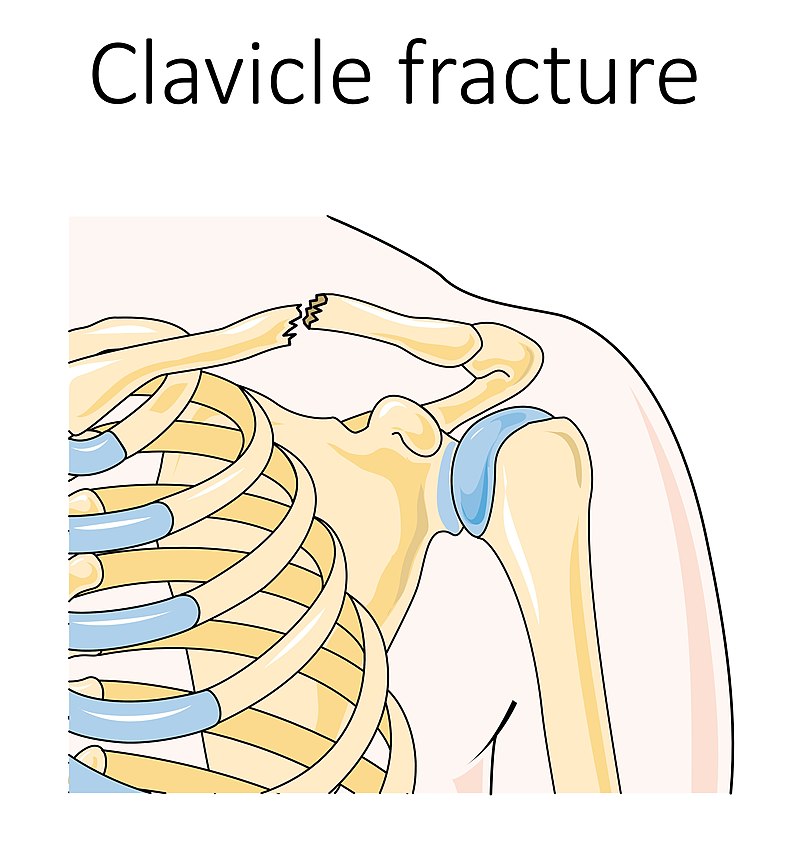 J Am Acad Orthop Surg 1997; 5(1): 11-18.
J Am Acad Orthop Surg 1997; 5(1): 11-18.
Clavicle fractures are most often caused by a direct blow to the shoulder. This can happen during a fall onto the shoulder or an accident, like a car collision. A fall onto an outstretched arm can also cause a clavicle fracture. In a baby, a clavicle fracture can occur during the passage through the birth canal.
A clavicle fracture can be very painful and may make it hard to move your arm. Other signs and symptoms of a fracture may include:
- Sagging of the shoulder downward and forward
- Inability to lift the arm because of pain
- A grinding sensation when you try to raise the arm
- A deformity or bump over the break
- Bruising, swelling, and/or tenderness over the collarbone
To Top
Physical Examination
Your doctor will want to know how the injury occurred and will ask about your symptoms. They will then carefully examine your shoulder.
In a clavicle fracture, there is usually an obvious deformity, or bump, at the fracture site. Gentle pressure over the break will bring about pain. Although it is rare for a bone fragment to break through the skin, it may push the skin into a tent formation.
In a clavicle fracture, the broken ends of the bone may cause tenting of the skin over the fracture site.
Your doctor will also perform tests to ensure that no nerves or blood vessels were damaged when the fracture occurred.
Imaging Studies
X-rays. X-rays provide images of dense structures, such as bone. Your doctor will order an X-ray:
- To help pinpoint the location of the fracture
- To learn more about the severity of the break
The doctor may also order X-rays of your entire shoulder to check for additional injuries.
If other bones are broken, your doctor may order a computerized tomography (CT) scan to see the fractures in better detail.
X-ray shows a fracture in the middle of the clavicle. Note how far out of place (displaced) the broken ends of the bone are.
Nonsurgical Treatment
If the broken ends of the bones have not significantly shifted out of place, you may not need surgery. Many broken collarbones can heal without surgery.
Nonsurgical treatment may include:
- Arm support. A simple arm sling is usually used for comfort immediately after the break and to keep your arm and shoulder in position while the injury heals.
- Medication. Pain medication, including acetaminophen, can help relieve pain as the fracture heals.
- Physical therapy. Although there will be some pain, it is important to maintain arm motion to prevent shoulder and elbow stiffness. Often, patients will begin doing exercises for elbow motion immediately after the injury.
After a clavicle fracture, it is common to lose some shoulder and arm strength.
 Once the bone begins to heal, your pain will decrease and your doctor may start gentle shoulder exercises. These exercises will help prevent stiffness and weakness. You will start more strenuous exercises gradually once the fracture is completely healed.
Once the bone begins to heal, your pain will decrease and your doctor may start gentle shoulder exercises. These exercises will help prevent stiffness and weakness. You will start more strenuous exercises gradually once the fracture is completely healed.
Follow-up care. You will need to see your doctor regularly until your fracture heals. During these visits, the doctor will take X-rays to make sure the bone is healing in a good position. After the bone has healed, you will be able to gradually return to your normal activities.
Complications. In some cases, a clavicle fracture can move out of place before it heals. It is important to follow up with your doctor as scheduled to make sure the bone stays in position.
If the fracture does not heal, it is called a nonunion.
- In some cases of nonunion, the patient has very little pain and good motion, so no further treatment is required.
- In other cases, nonunion can result in significant pain and may require an operation for repair.

If the fracture fragments do move out of place and the bones heal in that position, it is called a malunion. Surgical treatment for this is very rare, determined by how far out of place the bones are and how much this affects your arm movement.
A large bump over the fracture site may develop as the fracture heals. This usually gets smaller over time, but a small bump often remains permanently.
Surgical Treatment
If the broken ends of the bones have significantly shifted out of place, your doctor may recommend surgery.
Surgery typically involves putting the broken pieces of bone back into position and preventing them from moving out of place until they are healed. This can improve shoulder strength when you have recovered.
Open reduction and internal fixation. This is the procedure most often used to treat clavicle fractures. During the procedure, the bone fragments are first repositioned (reduced) into their normal alignment. The pieces of bone are then held in place with special metal hardware.
The pieces of bone are then held in place with special metal hardware.
Common methods of internal fixation include:
- Plates and screws. After being repositioned into their normal alignment, the bone fragments are held in place with special screws and metal plates attached to the outer surface of the bone.
After surgery, you may notice a small patch of numb skin below the incision. This numbness will become less noticeable with time. Because the clavicle lies directly under the skin, you may be able to feel the plate through your skin.
Plates and screws are not routinely removed after the bone has healed, unless they are causing discomfort. Problems with the hardware are not common, but some patients find that seatbelts and backpacks can irritate the collarbone area. If this happens, the hardware can be removed after the fracture has healed.
(Left) X-ray shows a displaced clavicle fracture (arrow). (Right) The pieces of bone have been realigned and held in place with plates and screws.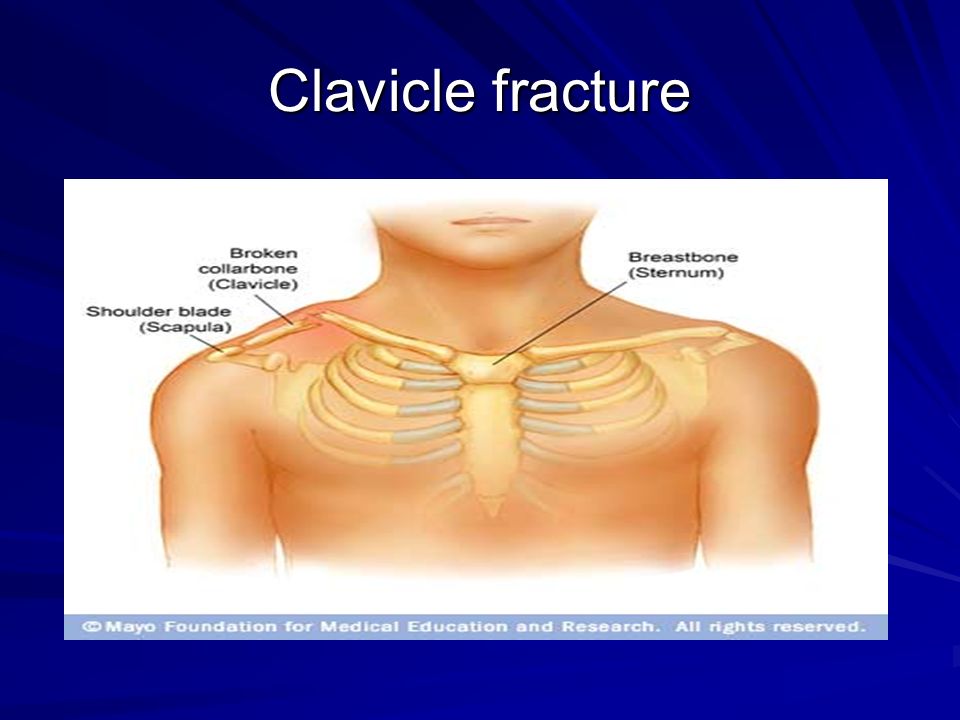
(Left) X-ray shows a severely displaced clavicle fracture (arrow). (Right) Here, a single screw has been used to repair the fracture.
Reproduced from Eichinger JK, Balog TP, Grassbaugh JA: Intramedullary fixation of clavicle fractures: anatomy, indications, advantages, and disadvantages. J Am Acad Orthop Surg 2016; 24(7): 455-464.
Pain management. After surgery, you will feel some pain.This is a natural part of the healing process. Many patients find that using ice and non-prescription pain medications are sufficient to relieve pain.
If your pain is severe, your doctor may suggest a prescription-strength medication, such as an opioid, for a few days.
Be aware that although opioids help relieve pain after surgery, they are a narcotic and can be addictive. Opioid dependency and overdose have become critical public health issues. For this reason, opioids are typically prescribed for a short period of time. It is important to use opioids only as directed by your doctor and to stop taking them as soon as your pain begins to improve.
It is important to use opioids only as directed by your doctor and to stop taking them as soon as your pain begins to improve.
Rehabilitation. Specific exercises will help restore movement and strengthen your shoulder. Your doctor may provide you with a home therapy plan or suggest that you work with a physical therapist.
Therapy programs typically start with gentle motion exercises. Your doctor will gradually add strengthening exercises to your program as your fracture heals.
Although it is a slow process, following your physical therapy plan is an important factor in returning to all the activities you enjoy.
Complications. There are risks associated with any type of surgery. These include:
- Infection
- Bleeding
- Problems with wound healing
- Pain
- Blood clots
- Damage to blood vessels or nerves
- Reaction to anesthesia
Risks that are specific to surgery for clavicle fractures include:
- Difficulty with bone healing
- Lung injury
- Numbness below the clavicle
- Hardware irritation
Patients who smoke or use tobacco products, have diabetes, or are elderly are at a higher risk for complications both during and after surgery.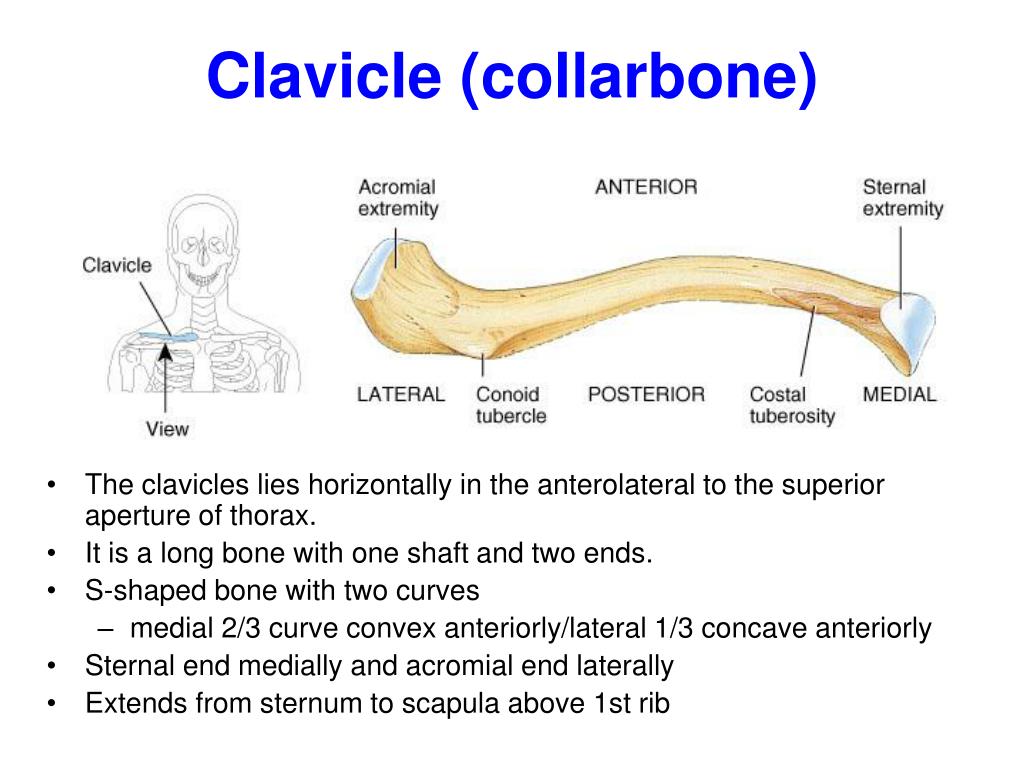 They are also more likely to have problems with wound and bone healing.
They are also more likely to have problems with wound and bone healing.
Learn more: Smoking and Musculoskeletal Health
Learn more: Surgery and Smoking
Before your surgery, your doctor will discuss each of the risks with you and will take specific measures to avoid complications.
Whether or not your treatment involves surgery, it can take several months for your collarbone to heal. Healing may take longer in diabetics or in people who smoke or use tobacco products.
Most people return to their regular activities within 3 months of their injury. Your doctor will tell you when your injury is stable enough to do so. Returning to regular activities or lifting with your arm before your doctor advises may cause the fracture fragments to move or the hardware to break. This may require you to start your treatment from the beginning.
Once your fracture has completely healed, you can safely return to sports activities.
Questions to Ask Your Doctor
If you experience a clavicle fracture, here are some questions you may wish to ask your doctor:
- When can I start using my arm?
- When can I return to work?
- Do I have any specific risks for not doing well?
- If I have to have surgery, what are the risks and benefits, and will I need to stay in the hospital?
- What are the risks and benefits of nonsurgical treatment?
To Top
Broken Collarbone (Clavicle Fracture) (for Teens)
en español: Fractura de clavícula
Reviewed by: Susan M. Dubowy, PA-C
Dubowy, PA-C
What Is a Broken Collarbone?
Your collarbone (or clavicle) is the bone that runs horizontally between the top of your breastbone (
sternum) and shoulder blade (scapula). You can feel your collarbone by touching the area between your neck and your shoulder. A broken collarbone, also called a clavicle fracture, is when this bone breaks.
How Does a Broken Collarbone Happen?
Falling hard on a shoulder or an outstretched arm can cause a broken collarbone.
These fractures are common in contact sports like football, wrestling, rugby, lacrosse, and hockey. They also can happen in sports where there is a chance of falling hard, such as biking, skiing, snowboarding, and skateboarding.
A collarbone also can break in a car crash or if someone is hit by a car.
What Are the Signs & Symptoms of a Broken Collarbone?
Someone who breaks a collarbone may have:
- pain over the collarbone
- trouble moving the arm or shoulder on that side
- swelling, tenderness, and bruising along the collarbone
- a bulge or “tenting” of the skin above the break
How Are Broken Collarbones Diagnosed?
To diagnose a collarbone fracture, a health care provider will:
- ask about the injury
- do a physical exam
- order X-rays
How Are Collarbone Fractures Treated?
Most broken collarbones heal with ice, arm support, pain medicine, and exercises.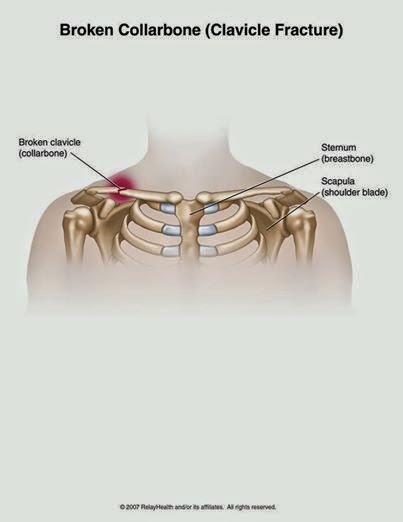 The arm is supported either by a sling or a shoulder immobilizer. A shoulder immobilizer is like a sling but it also has a strap that goes around the waist.
The arm is supported either by a sling or a shoulder immobilizer. A shoulder immobilizer is like a sling but it also has a strap that goes around the waist.
While the collarbone heals:
- Use ice for pain and swelling. Put an icepack, cold gel pack, or bag of frozen vegetables over the collarbone for 20–30 minutes every 2–3 hours. Be sure to put a towel between the ice/cold pack and your skin.
- Use the sling or shoulder immobilizer as directed by your health care provider. You’ll wear it for about a month, but can remove it during bathing and sleeping.
- Follow your health care provider’s instructions for using medicine for pain.
For about the first 4–6 weeks:
- Avoid raising your arms above shoulder level.
- Avoid lifting anything that weighs more than 5 pounds (2.3 kg). This is about the weight of a 72-ounce bottle of liquid laundry detergent.
- Stay out of all sports and physical education.
- Do all exercises to prevent elbow and shoulder stiffness and to help with muscle strength.

- Go to physical therapy, if needed.
- Go to all follow-up appointments.
Call your health care provider if your pain or swelling gets worse.
Will the Collarbone Heal Straight?
Even if the broken bones aren’t perfectly lined up, the body usually can make them straight again. That’s because the collarbone has a thick periosteum (outer layer of the bone). The collarbone periosteum doesn’t usually break, so it acts like a sleeve to hold the bone together while it heals. Rarely, the doctor might recommend surgery if the broken bones are very out of line.
Sometimes while the broken collarbone heals, there is a bump where the bone was broken. Sometimes the bump doesn’t fully go away. But it doesn’t hurt or cause other problems with the arm or shoulder.
When Can I Go Back to Sports?
Your health care provider will see you again and let you know when it’s OK to go back to sports. This is usually when:
- There’s no pain when the health care provider presses on the collarbone.

- Your shoulder strength is normal.
- You can move and use the arm and shoulder without pain.
- In general, people can go back to noncontact sports (such as running or swimming) in about 6 weeks and contact sports (such as football, lacrosse, and hockey) in 8–12 weeks.
Can Broken Collarbones Be Prevented?
Because collarbone fractures happen suddenly and unexpectedly, it can be hard to prevent them. But to decrease your risk:
- When playing contact sports, wear all the recommended protective gear and learn the proper techniques for your sport.
- Keep your bones strong by eating a well-balanced diet. Be sure to eat lots of vegetables and foods that are rich in calcium and vitamin D to help build strong bones.
- Do strength training and stretching to build strong, flexible muscles. Muscles that are strong and flexible will help support your bones better and keep you agile and less likely to experience a hard fall.
 A proper warm-up, including dynamic stretching exercises, can help your muscles perform at their best during play.
A proper warm-up, including dynamic stretching exercises, can help your muscles perform at their best during play. - Wear well-fitting, supportive footwear that’s right for your sport.
Looking Ahead
Most broken collarbones heal quickly and completely. Within a few months, you should be back to doing all the things you enjoyed before the injury.
Reviewed by: Susan M. Dubowy, PA-C
Date reviewed: June 2018
Share:
/content/kidshealth/misc/medicalcodes/teens/articles/clavicle-fracture
Fracture of the collarbone – treatment, symptoms, causes, diagnosis
Fracture of the collarbone is a fairly common injury, especially in adolescents and young adults. The clavicle connects the upper part of the sternum to the shoulder blade. The most common cause of a clavicle fracture is falls, sports injuries, and injuries during traffic accidents. Newborns sometimes have a collarbone fracture during the birth process. If you suspect a clavicle fracture, you should definitely consult a doctor. In most cases, a clavicle fracture is treated conservatively with a bandage and physical therapy. Complex fractures of the clavicle require surgical treatment with fixation with plates, screws or rods, which allows the bone tissue to consolidate.
The clavicle connects the upper part of the sternum to the shoulder blade. The most common cause of a clavicle fracture is falls, sports injuries, and injuries during traffic accidents. Newborns sometimes have a collarbone fracture during the birth process. If you suspect a clavicle fracture, you should definitely consult a doctor. In most cases, a clavicle fracture is treated conservatively with a bandage and physical therapy. Complex fractures of the clavicle require surgical treatment with fixation with plates, screws or rods, which allows the bone tissue to consolidate.
Symptoms
Symptoms of a clavicle fracture include:
- pain that worsens with movement of the shoulder
- edema
- soreness
- contusion
- presence of swelling in the shoulder area
- Grinding or crackling when trying to move the shoulder
- stiffness or inability to move the shoulder
Therefore, if there are signs or symptoms of a clavicle fracture, or if there is pain in the shoulder that does not allow the shoulder to move normally, then it is imperative to see a doctor. Untimely diagnosis and treatment of a clavicle fracture can lead to slow healing of the fracture.
Untimely diagnosis and treatment of a clavicle fracture can lead to slow healing of the fracture.
Causes
The most common causes of a clavicle fracture include:
- Falls. A fall on your shoulder or on an outstretched arm can lead to a broken collarbone.
- Sports injuries. A direct blow to the shoulder while playing on the field (football, hockey, etc.) or martial arts in the ring can cause a fracture of the collarbone.
- Automobile injuries. A broken collarbone can result from an accident while driving a car, motorcycle, or bicycle.
- Birth trauma. In newborns, a clavicle fracture can occur during the birth process.
- Young age is a risk factor, as the bone tissue of the clavicle finally completes its formation by the age of 20. And therefore, adolescents and young adults are at higher risk for a collarbone fracture. The risk of fracture also increases in old age, as the strength of bone tissue decreases due to the development of osteoporosis.

Complications
In most cases, a clavicle fracture heals without consequences. But sometimes the following complications are possible:
- Damage to nerves or blood vessels. The pointed ends of a broken collarbone can damage nearby nerves and blood vessels and, in such cases, it can cause numbness or coldness in the hand.
- Poor or slow healing. With a severe fracture of the clavicle, the consolidation of bone fragments may be slow or incomplete. Poor alignment of bone fragments can lead to shortening of the clavicle, which leads to a violation of the normal range of motion in the shoulder.
- Bone outgrowths may be part of the process of bone regeneration (bone callus) and are visible because the clavicle is not deep under the skin. But callus usually disappears after a while. But sometimes bone growths persist for a long time.
- Bone infections. In cases where fragments of the clavicle violate the integrity of the skin, then there is the possibility of infection penetrating into the bone tissue.
 Therefore, timely adequate treatment for such fractures is of great importance.
Therefore, timely adequate treatment for such fractures is of great importance. - Arthrosis. If a clavicle fracture occurred in the joint area at the junction with the sternum or scapula, then there is a certain risk of developing arthrosis of these joints.
Diagnosis
During a physical exam, the doctor examines the injured area for tenderness, swelling, deformity, or an open sore. X-rays are usually sufficient to diagnose a clavicle fracture. In some cases, an additional examination (CT or MRI) may be prescribed to diagnose possible soft tissue damage in a clavicle fracture.
Treatment
Immobilization is a prerequisite for a fracture of any bone (including the collarbone). In case of a clavicle fracture, immobilization can be performed using a kerchief bandage or using Delbe rings, which make it possible to preserve the length of the clavicle to a greater extent after consolidation of bone fragments.
The duration of immobilization depends on the severity of the fracture. Typically, clavicle bone regeneration takes 3 to 6 weeks in children and 6 to 12 weeks in adults. If there was a fracture of the clavicle in a newborn during childbirth, then the treatment will consist only in careful care.
Typically, clavicle bone regeneration takes 3 to 6 weeks in children and 6 to 12 weeks in adults. If there was a fracture of the clavicle in a newborn during childbirth, then the treatment will consist only in careful care.
Drug treatment consists of prescribing anti-inflammatory drugs to reduce pain.
Rehabilitation. It is necessary to begin movement in the shoulder some time after immobilization (in a small amount), which will avoid impaired mobility in the shoulder or the development of the “frozen shoulder” syndrome. After removing the bandage, it is necessary to conduct a course of exercise therapy, which will restore muscle strength and joint mobility.
Surgical treatment
Surgical treatment for fracture of the clavicle is necessary in cases where fragments of the clavicle violate the integrity of the skin with a strong displacement of the fragments or the presence of a comminuted fracture. An osteosynthesis operation is performed when the fragments are connected with the help of screws of the bolt plates.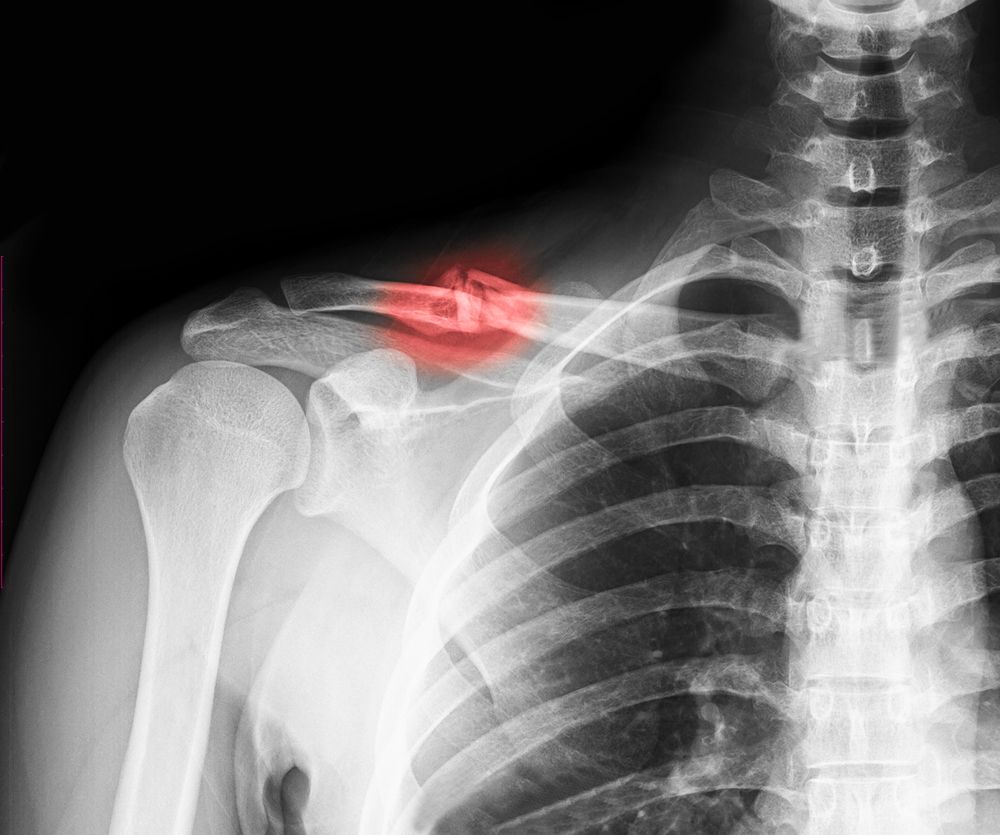 Complications in surgical treatment of clavicle fractures are quite rare.
Complications in surgical treatment of clavicle fractures are quite rare.
Clavicle fracture
Hospital departments
Home » Hospital departments » Traumatology department » Clavicle fractures
Brief anatomy
The clavicle is a small, S-curved tubular bone that connects at one end to the sternum (sternoclavicular joint) and at the other end to the acromial process of the scapula (a cromioclavicular joint). Fracture of the clavicle can occur anywhere, but most often the fracture is localized in the area of the diaphysis, less often in the area of the acromial end of the clavicle, and even more rarely in the area of the sternal end (20.8 and 1 case per 100,000 population per year, respectively).
Mechanism of injury:
The typical cause of a clavicle fracture is trauma (direct blow or fall on the arm). The clavicle gains maximum strength by the age of 20.
Classification of fractures:
There are fractures of the clavicle with displacement and without displacement, and they can also be divided into closed and open. It is worth noting that open fractures of this type are quite rare, and this happens most often due to a direct blow to the clavicle area. Open fractures of the clavicle most often occur as a result of a traffic accident or a fall from a great height. Regarding the location, fractures of the outer, middle and inner thirds of the clavicle can be distinguished. Most often, it is the middle third that breaks during fractures, because it is the thinnest place of the entire bone. Another criterion is the nature of fragments at a fracture, and they can be divided into oblique, comminuted, oblique and transverse
It is worth noting that open fractures of this type are quite rare, and this happens most often due to a direct blow to the clavicle area. Open fractures of the clavicle most often occur as a result of a traffic accident or a fall from a great height. Regarding the location, fractures of the outer, middle and inner thirds of the clavicle can be distinguished. Most often, it is the middle third that breaks during fractures, because it is the thinnest place of the entire bone. Another criterion is the nature of fragments at a fracture, and they can be divided into oblique, comminuted, oblique and transverse
Symptoms:
• Anterior and downward displacement of the shoulder
• Inability to raise the arm due to pain
• Cracking sensation (crepitus) when trying to raise the arm up
• Deformity or unevenness in the clavicle;
• Pain in shoulder girdle.
Diagnosis:
Visual inspection. The “gold standard” radiography of the clavicle in two projections.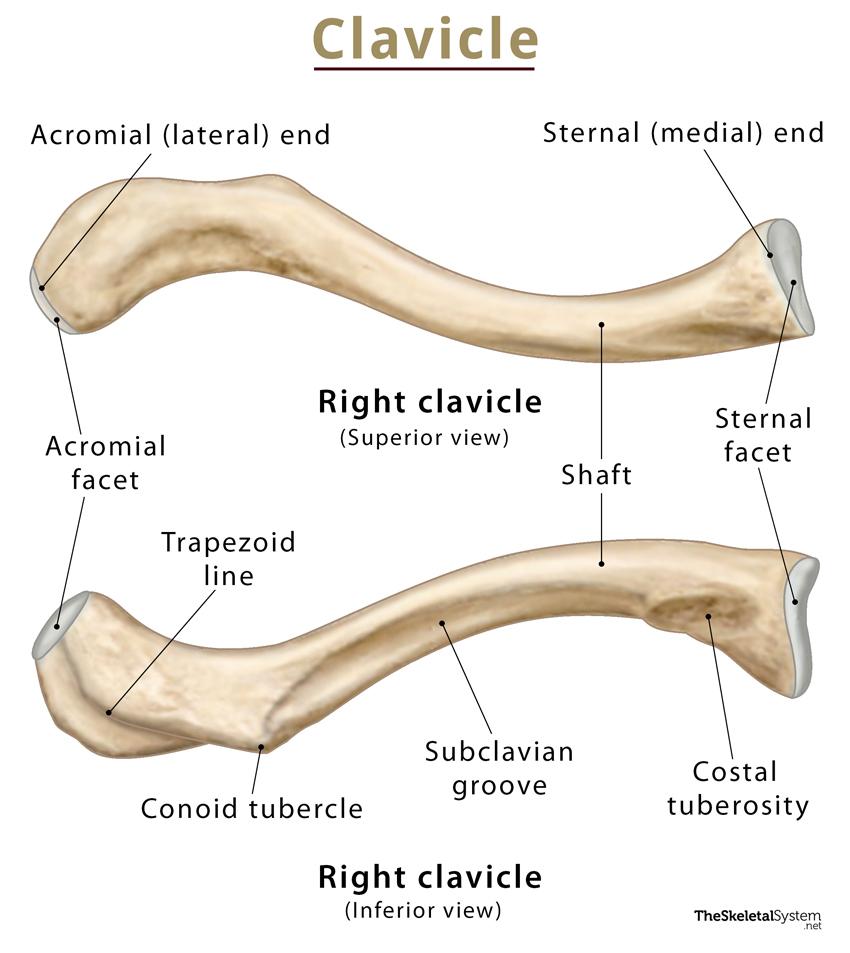 In rare cases, a CT scan (fractures of the sternal end of the clavicle) is required for diagnosis.
In rare cases, a CT scan (fractures of the sternal end of the clavicle) is required for diagnosis.
Treatment:
Conservative treatment: after reposition, the shoulder girdle is fixed with a plaster cast or orthosis. The term of immobilization is 4-5 weeks. With conservative treatment, there is a high risk of nonunion or malunion of the fracture. In this regard, the function of the entire upper limb is impaired.
Surgical treatment in our clinic:
During this operation, the displacement of fragments is eliminated and the bone is fastened with a metal structure, the choice of which is determined by the nature of the fracture.
Currently, osteosynthesis with plates and screws is the most widely used. If the fracture is localized in the diaphysis, then conventional reconstructive plates or special S-curved plates for the clavicle are suitable. But if the fracture, the fracture line affects the acromial end of the clavicle, then other constructions may be needed.
Operational access: 1. Longitudinal incision parallel to the clavicle; 2. Transverse (saber strike).
Treatment of diaphyseal fractures of the clavicle.
Position of the patient on the back in the “beach chair” position. Anesthesia: conduction anesthesia or endotracheal anesthesia. The operation is performed as soon as possible using modern techniques and implants. Implants made in Switzerland and Germany. Implant material: titanium or medical steel.
Before surgery:
After surgery:
After surgery, patients can start restoring limb function the next day. In our department, an exercise therapy instructor works with each patient. Gymnastics, massage, physiotherapy. Patients return to their daily lives after the operation as soon as possible.
Treatment of fractures of the acromial end of the clavicle.

 Once the bone begins to heal, your pain will decrease and your doctor may start gentle shoulder exercises. These exercises will help prevent stiffness and weakness. You will start more strenuous exercises gradually once the fracture is completely healed.
Once the bone begins to heal, your pain will decrease and your doctor may start gentle shoulder exercises. These exercises will help prevent stiffness and weakness. You will start more strenuous exercises gradually once the fracture is completely healed.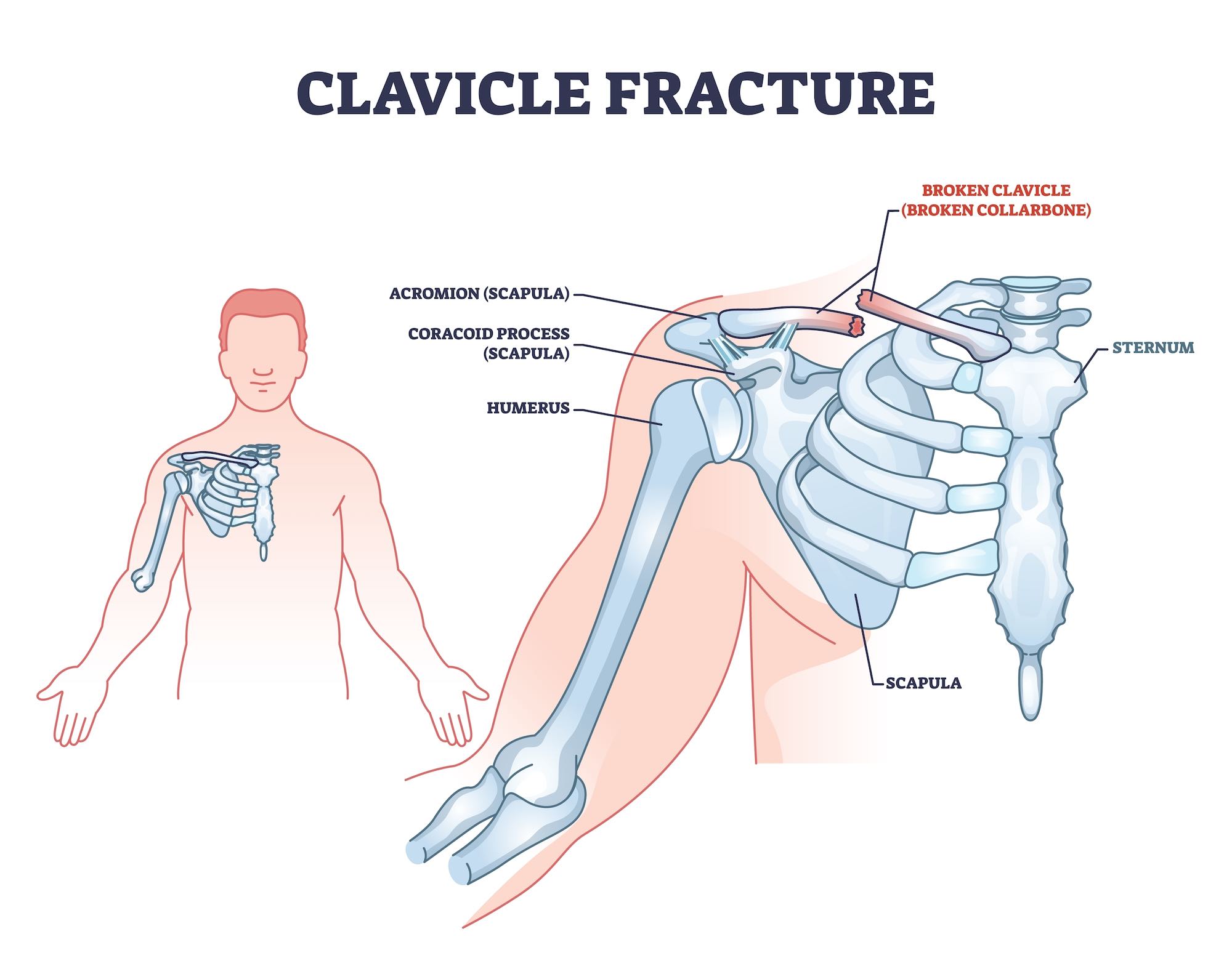

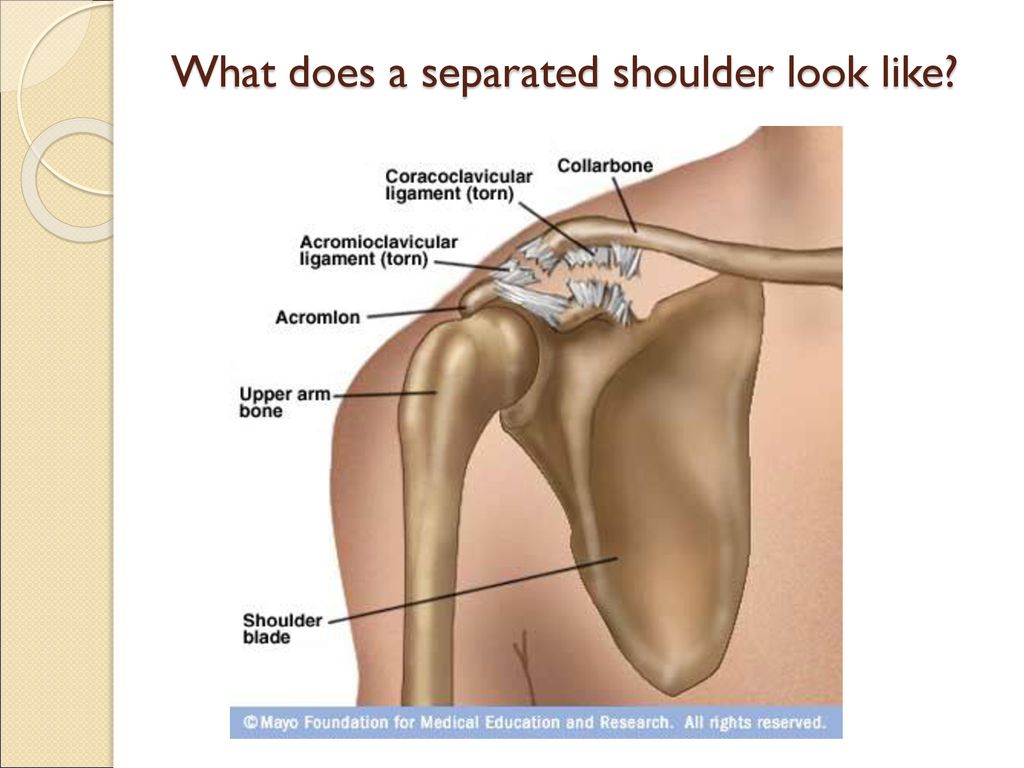
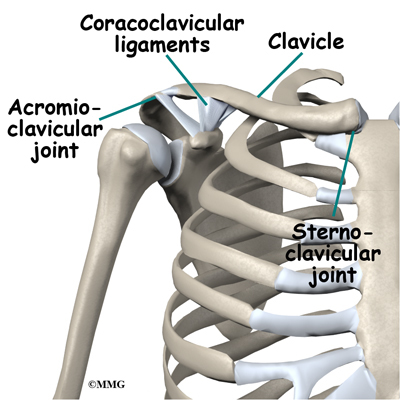 A proper warm-up, including dynamic stretching exercises, can help your muscles perform at their best during play.
A proper warm-up, including dynamic stretching exercises, can help your muscles perform at their best during play.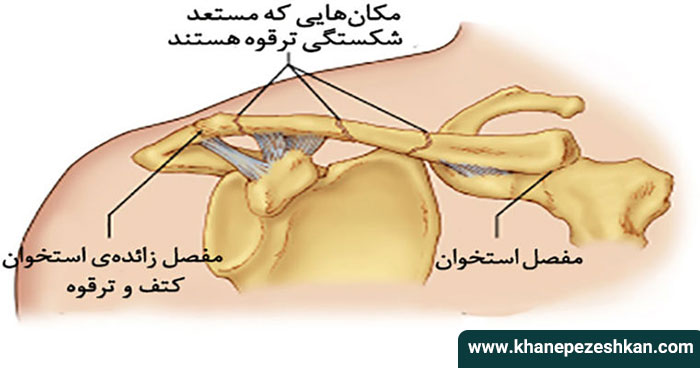
 Therefore, timely adequate treatment for such fractures is of great importance.
Therefore, timely adequate treatment for such fractures is of great importance.